There was a time in the distant past when Americans considered the threat of nuclear annihilation to be a more imminent threat. People built fallout shelters, and schools practiced drills, teaching children what to do if bombs fell. On the ground, your only warning might have been the sound of an air-raid siren, and one company built the loudest of them all. During the Cold War, Chrysler built a car-sized air-raid siren so loud that it could be heard from up to 16 miles away. Powering the world’s loudest siren was none other than Chrysler’s iconic Hemi V8.
If you are one of the younger readers of The Autopian, or at the very least, were born after 1991, you didn’t get to experience the tensions of the Cold War. That includes me, as I was born after the fall of the Soviet Union. During the Cold War, which took place in the decades following World War II, nuclear arms proliferated around the world and tensions between the United States and the Soviet Union reached dangerous levels. The effects of the Cold War were felt at home, and American life changed around them.
As the National Humanities Center notes, the Cold War touched every facet of the American condition. Hollywood produced horrific movies that played with fears of nuclear war and unwelcome invaders. Families were told to conform and unite to stand against a common enemy. If you did something that the government could have viewed as “un-American” or Communist, you could have lost your livelihood. One of the most iconic films in history, “Dr. Strangelove, Or, How I Learned To Stop Worrying And Love The Bomb,” was a Cold War flick.
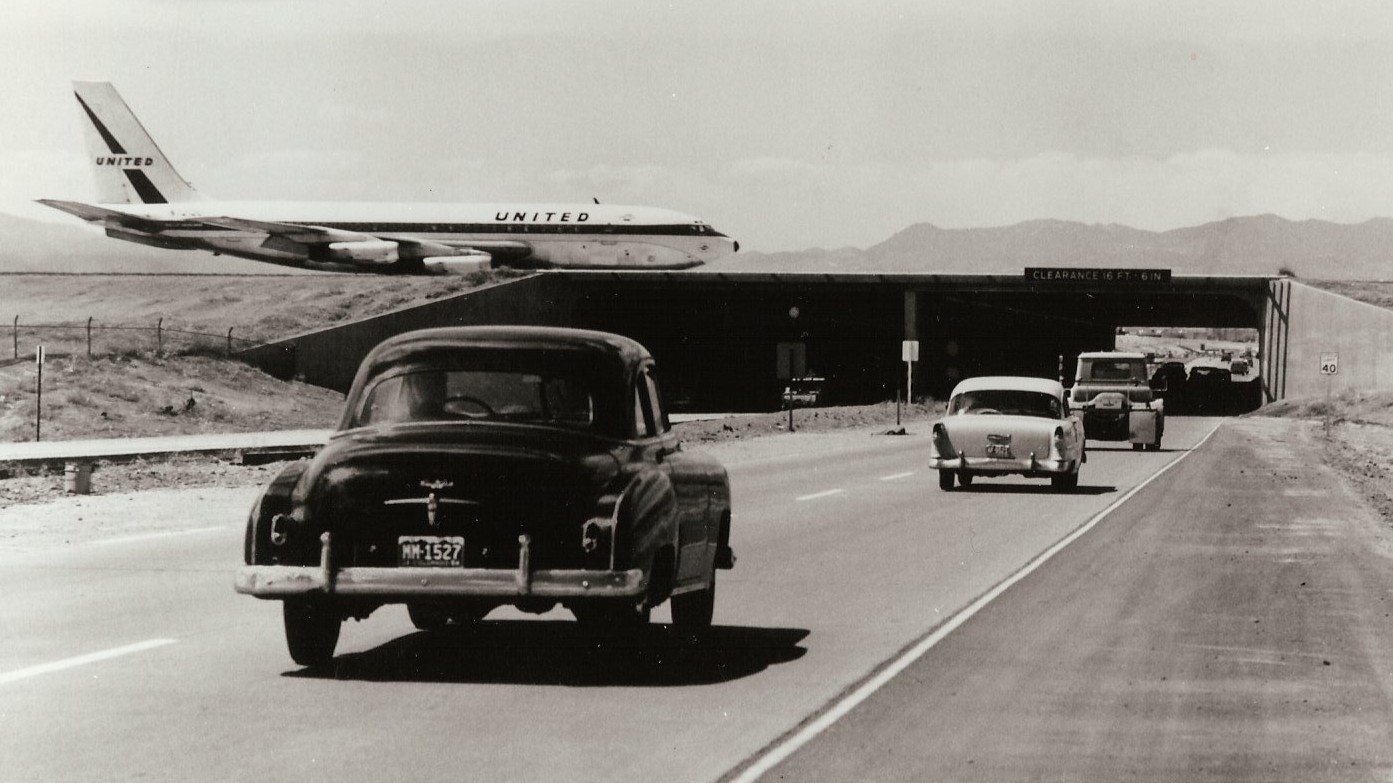
Then there were the even darker parts of American Cold War life, namely, the idea that, at any moment, the bombs could fall. As Business Insider writes, libraries were armed with materials to teach people how to render first aid and how to survive the fallout of a nuclear war. Even the Space Race had a different feel than how many remember it today, as many people back then feared that letting the Soviets get to space and the moon first would give them a militaristic advantage.
Some drastic efforts were taken to do something, anything, to help people in the event that the bombs fell. Some families built bomb shelters, while schools taught children to “Duck and Cover.” We also erected and tested massive air-raid sirens that served as perhaps the last warning a person might get to find cover. Thankfully, the grimmest fears of the Cold War did not become reality, even though there were times when they almost did.
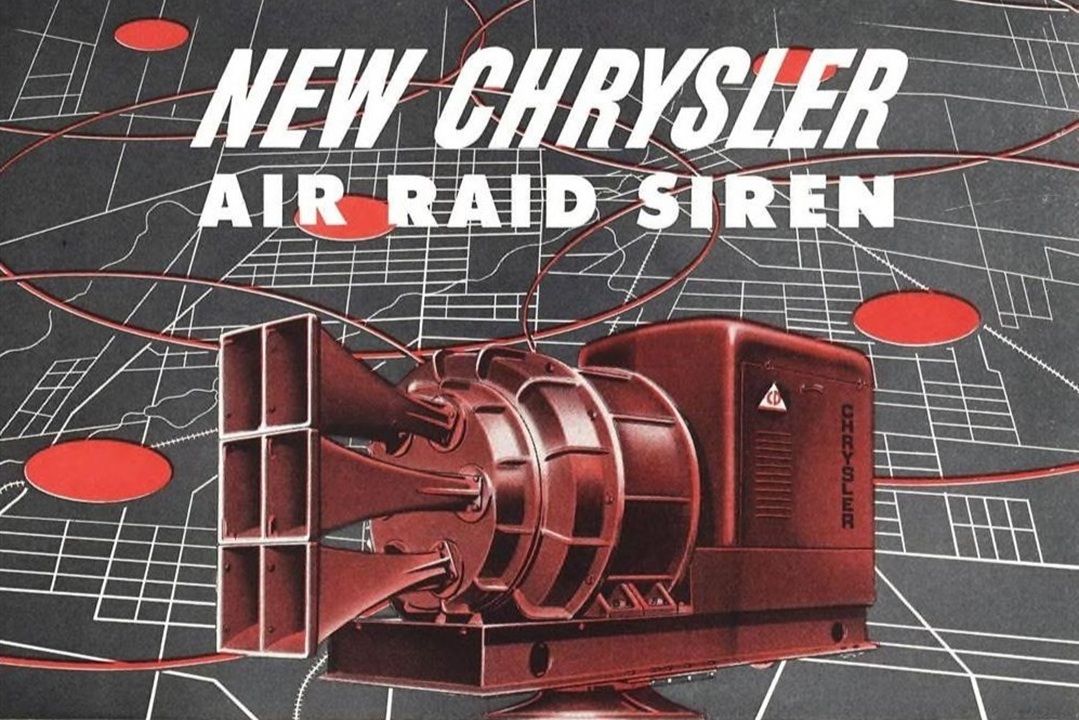
One famous relic of the era was the Chrysler Air Raid Siren. When this Hemi V8 car engine-powered beast entered production, it produced a siren that was as loud as a fighter jet taking off and had the range to travel several miles through rural areas. Today, they’re a weird reminder of what used to be.
Siren Songs
The air-raid siren actually predates the Cold War. Now, we aren’t exactly a siren site, so I’ll keep it short. The inventor of the siren is often credited to Scottish physicist John Robison. This was a simple device that used a wheel-driven stopcock that opened and closed a pneumatic tube. French engineer Baron Charles Cagniard de la Tour invented an improved siren around 1819.
The use of a siren to warn of airborne dangers rose to popularity in 1938 and 1939 when an elaborate network of sirens was constructed around Britain. These sirens were usually mounted on top of buildings or on poles if a suitable building was not available. Notably, at least for our story, was that these particular sirens were electrically powered.

Another way to describe a siren is that it’s an air chopper. The Canadian Civil Defence Museum And Archives describes how a basic electro-mechanical siren works:
An electro-mechanical siren is a fairly simple device. It consists of an electric motor which turns a fan called the “rotor” or “impeller”, spinning inside a slotted drum called the “stator”. The first job of the rotor is as a centrifugal fan. It pulls air into the siren axially through the intake, and blows it out radially through the holes in the stator. The second job of the rotor is to chop the incoming air stream into impulsive bursts. The rotor is segmented by vanes that periodically cover and uncover the holes in the stator. Each time the rotor and stator holes align, a burst of air is forced through. The frequency of these bursts is the pitch of the siren.
[…]
The siren gets its unique tone, or timbre, from the from the shape of the sound wave it produces. The chopping action of the rotor produces a triangular waveform that is rich in both odd and even harmonics. The first few harmonics are especially strong.
A variant of the siren is the so-called supercharged siren, which uses an external air compressor, such as a roots blower, to force air into the rotor. This greatly increases the decibel output of the siren and also allows the sound to travel farther. Typically, these blowers are electrically-driven. One of the earliest supercharged sirens was the famous Federal Signal Corporation Thunderbolt, which entered production in 1952.
Car-Powered Sirens

This supercharged point is important because the Chrysler Air Raid Siren is considered to be a supercharged siren. But a question I’ve long had is how on Earth does a car engine end up powering a siren? As the story goes, in the early stages of World War II, the War Production Board wanted an air-raid siren that could work independently of infrastructure. That way, if the enemy downed the electrical grid before striking with a bomb, civilians could still be warned. But this couldn’t just be any normal siren, either, as the Board wanted this siren to be so loud that it could replace hundreds of tiny electric sirens.
To facilitate this, the E.D. Bullard Company and Chrysler, and then later, Bell Telephone Laboratories, joined forces to create a marvel in siren science.
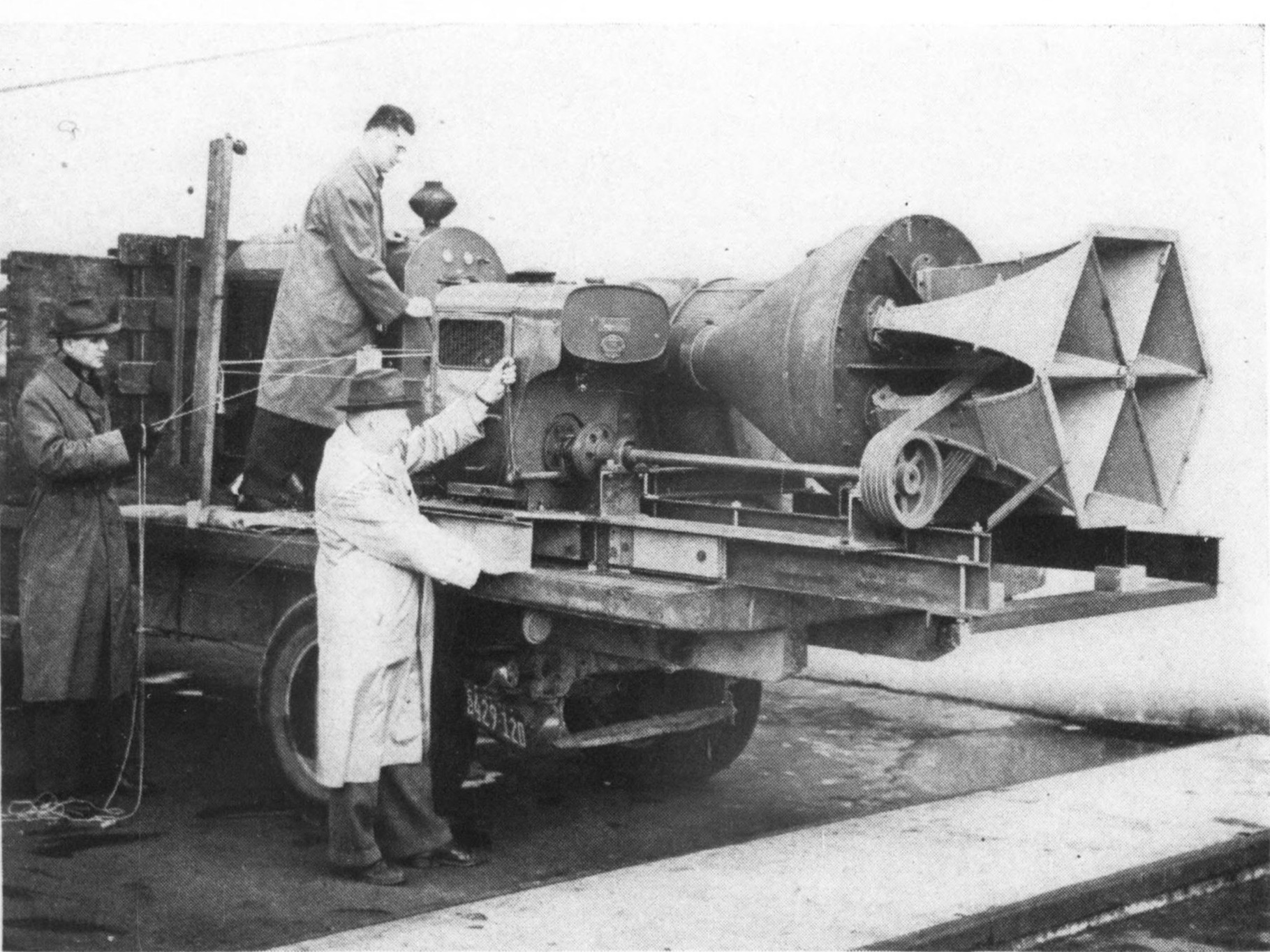
A 1995 issue of Horn & Whistle Magazine explains what happened from there:
Development of the Chrysler siren began around January, 1942, when the E. D. Bullard Co. of San Francisco submitted an engine-driven centrifugal siren to the Chrysler Division to see whether the straight 6-cylinder Chrysler Royal engine could be adapted to it. The output of this siren was inadequate, and it was concluded that improvements would have to be made for it to be useful as an air raid warning signal. Earlier it had been determined that a sound pressure level of 120 to 140 dB at 100 feet was needed for an effective warning. Despite considerable effort, the Bullard-type siren did not attain the necessary output. The problem was still under consideration when the Chrysler Corporation was invited to send representatives to a meeting called by the Office of Civil Defense (OCD) in Washington, DC on February 25, 1942, to inspect a new type of high output siren. This device was the experimental result of new sound-producing principles developed by the Bell Telephone Laboratories under the direction of Dr. Harvey Fletcher. The Bell Labs siren was brilliantly engineered and very powerful, producing a level of 137 dB at 100 feet.
[…]
In the Bell Labs design, the clearance between the rotor and the port faces is only 0.010 to 0.015 inches. If smaller, the chopper might rub against the ports, and if larger, the sound output drops to an unacceptably low level. The experimental Bell Labs siren used a compressor furnished by the American Locomotive Co. This blower was driven by a 95 HP Ford engine and delivered air at 5 PSIG. Tests showed that an additional 20 HP would be required to drive the chopper rotor at 5,000 RPM, and this was provided by a separate 20 HP Wisconsin engine. This siren produced a frequency of 440 Hz when the rotor was driven at 4,400 RPM. A great deal of ingenuity, experimentation, and thought went into the development of the high output Bell Labs siren.

The initial production version of the Bell siren design was called the Chrysler-Bell Victory Siren, and it entered production in 1942. These sirens used a 324 cubic inch Chrysler IND 9 straight-eight, good for 140 HP. The siren produced 137 dB at a frequency of 430 Hz at a distance of just 100 feet. The use of a two-stage compressor eliminated the need for a second engine and compressor. Approximately 120 of these sirens were sold to 28 cities, including Chicago, Detroit, and New York City, for $3,760 a piece.
What’s wild about the Victory Siren is that its operator had to sit on the siren, Slim Pickens-style, as it slowly spun on its turntable. That’s why historical images of the sirens do look pretty silly. Yes, that also meant that in a real emergency, the siren’s operator would get a front row seat to a nuclear apocalypse.

However, the sirens worked. In a 1942 issue of Science News Letter, the sirens were described as being as loud as “1,000 symphonies” playing at the same time, and magazines touted the sirens as being the “loudest sustained sound ever produced by man.” According to Chrysler, the Victory Siren was so loud that a city would have needed to purchase 128 low-powered, typical sirens to equal just one Victory Siren. Of course, Chrysler then noted that, unlike the Victory Siren, those other sirens would stop working as soon as the power goes out.
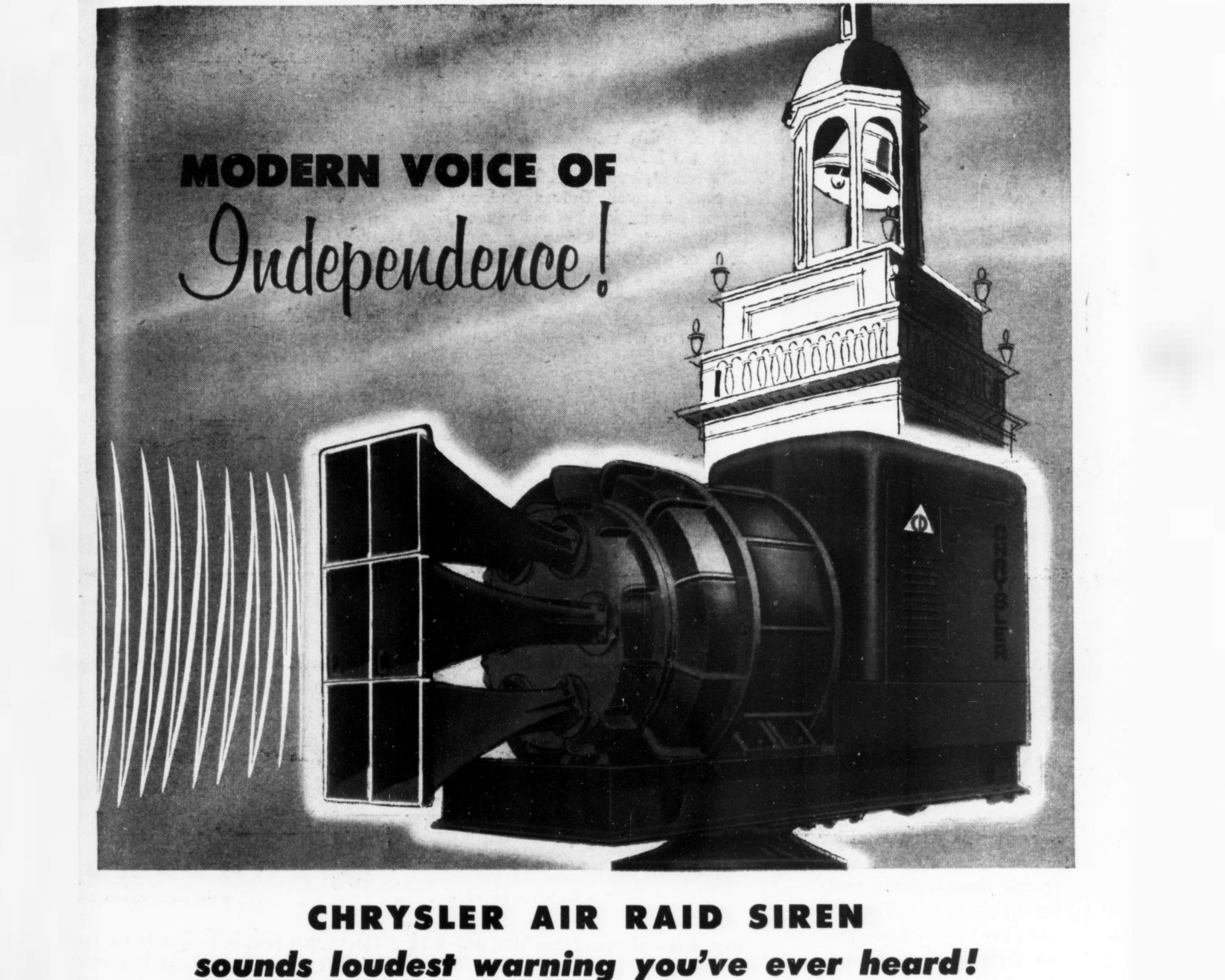
This loudness and the over 10 miles of travel the sound had (given few obstacles) was important, because cities were already very loud. When the siren was tested in New York City, Bell Telephone Laboratories engineers found that the siren blared at 15 dB louder than the background city noise. Thus, the siren was marketed as being able to pierce even the loudest city environments. Soon enough, city dwellers would hear the sounds of air-raid siren tests. I wonder how many of those people knew that the sirens were using car engines?
Given the smashing success of the Victory Siren, Chrysler also made a more compact version of the siren, which used a 236 cubic inch straight-six with 120 HP. This siren, Chrysler said, pushed 300 cubic feet per minute and weighed a svelte 1,600 pounds. Yes, that was considered lightweight because the big straight-eight siren actually weighed more than a ton.

Chrysler did not note a decibel range with this one. Instead, this smaller siren was designed to complement the Victory Siren. Specifically, Chrysler said it was to be deployed in areas where the Victory Siren’s sound wasn’t loud enough.
According to Horn & Whistle, the Victory Siren would get a second iteration. The second version, pictured above, which was renamed to just Chrysler Air Raid Siren, featured the same 137 dB and was powered by the same straight-eight engine, but had a more refined, cleaned-up appearance.
‘That Thing Got A Hemi?’
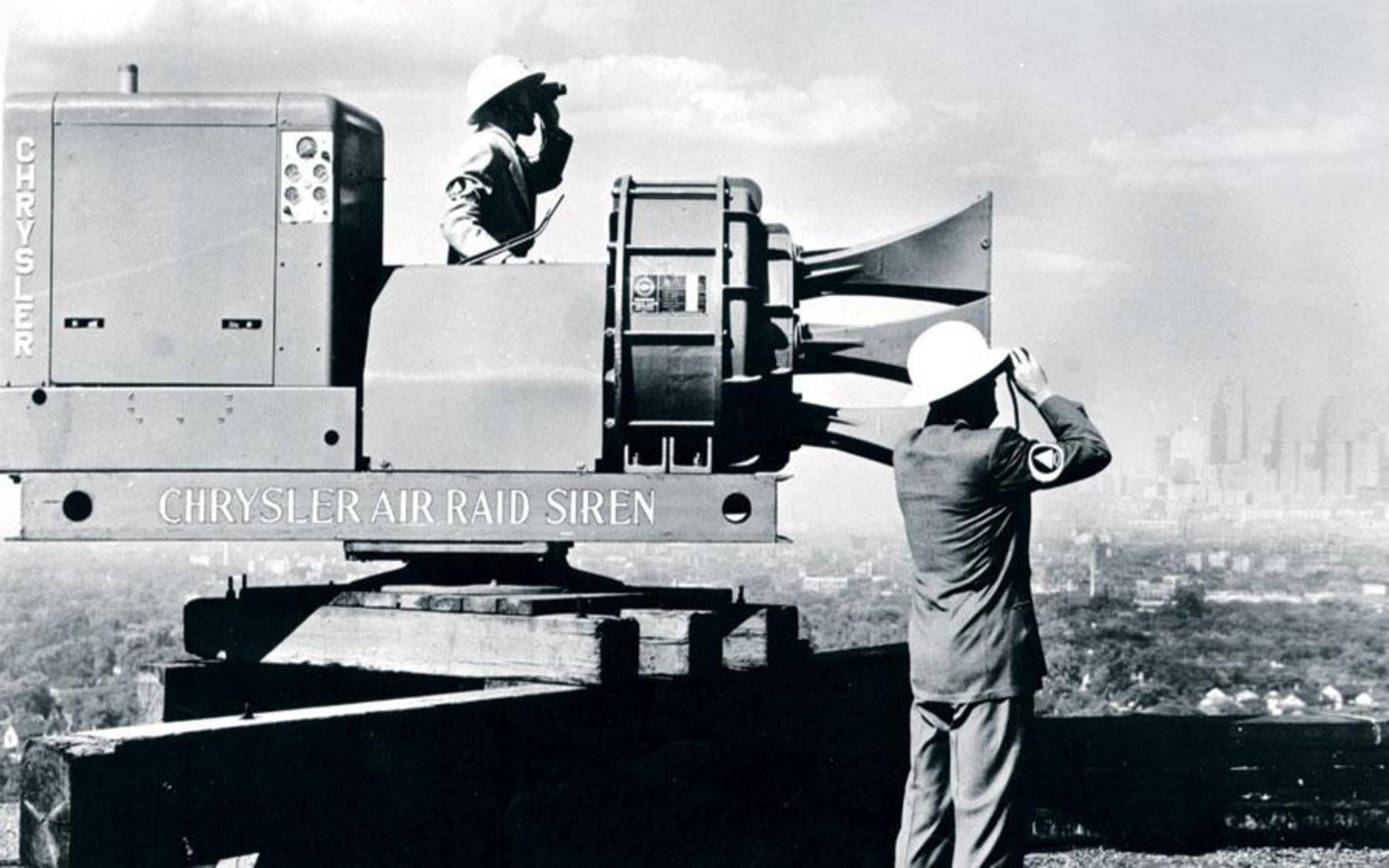
Then came the air raid siren to rule them all. In 1952, Chrysler launched the next generation of the Air Raid Siren, and this one was pretty nuts. From Horn & Whistle:
They were the official Civil Defense sirens used in large U.S. cities and other locations during the Cold War nuclear attack threat era of the 1950’s and 1960’s. They had new three-stage centrifugal blowers to compress the air to 6.95 PSI before it was chopped by the rotor. These sirens were also fitted with Chrysler’s new industrial 331 cu. in. hemi-head 180 HP V-8 gasoline engine. This siren produced an incredible 138 dB at 100 feet, and the frequency was 460 Hz at 4.600 RPM. It could be remotely controlled from inside a building or other location.
All four models had six horn-loaded ports. The three production model Chryslers had engine block heaters and heated battery cases, so that the sirens were ready to run down to -25°F in all weather and climates. Because the sound output was highly directional, they rotated at 1.5 RPM on a belt-driven turntable for full 360° coverage.
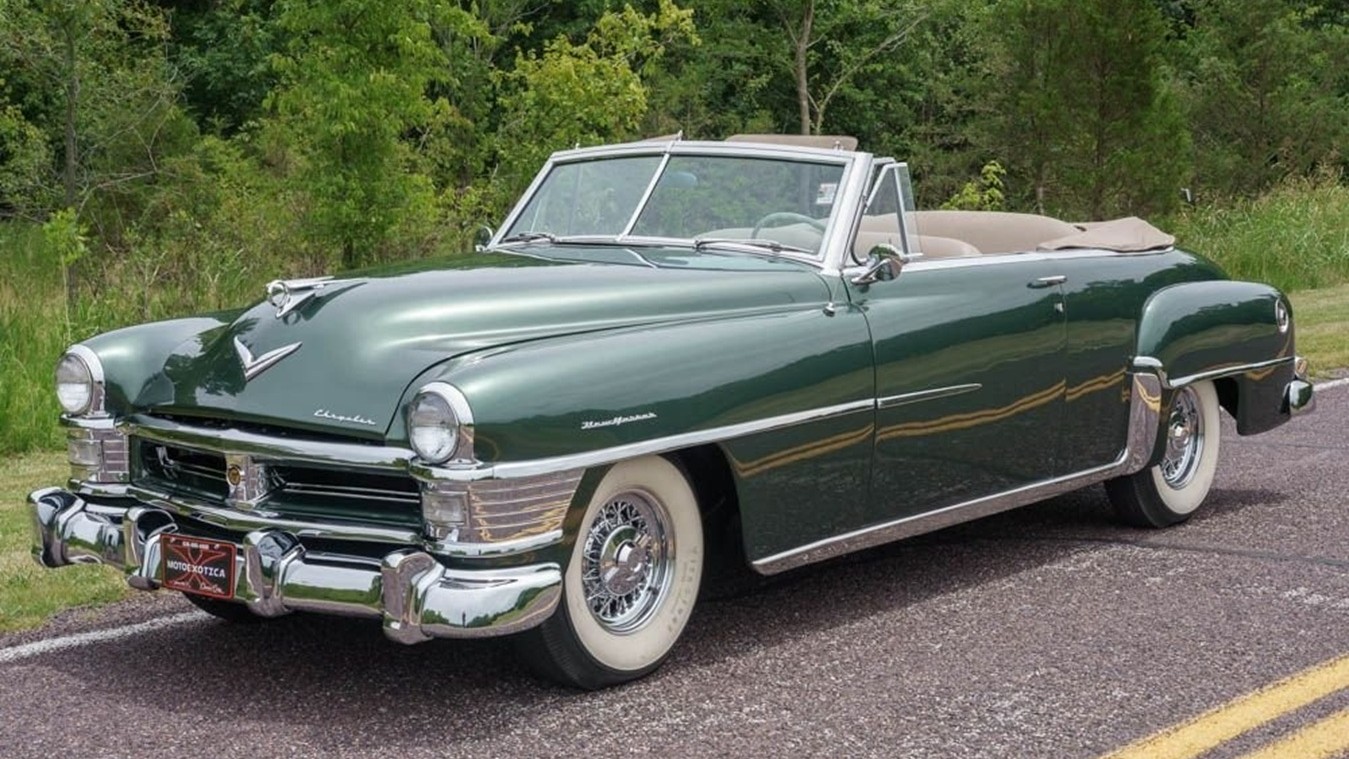

That’s right, the final version of the Chrysler Air Raid Siren was powered by a Hemi, or more specifically, a FirePower Hemi. At the time, this engine would have been found in cars like the Chrysler New Yorker, the Chrysler Saratoga, and the Imperial. The use of a FirePower in cars meant that Chrysler’s big boats had 20 more ponies in the stable than Cadillacs featuring that marque’s 331 cubic inch V8.
What’s so incredible about this siren is its performance. The previous iterations of Chrysler’s siren were already loud, but the Hemi version took it to another level. The Hemi siren was 12 feet long, weighed a whopping three tons, and was 138 dB at 100 feet. That’s about as loud as standing next to a fighter jet as it lights its afterburners. It’s so loud that it will damage your hearing.
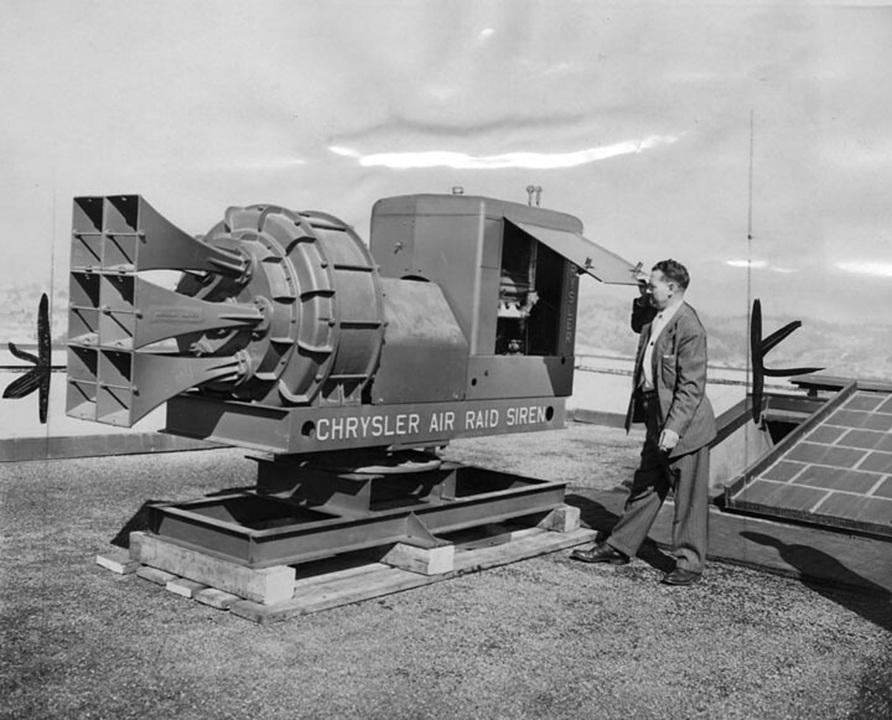
The Chrysler Air Raid Siren had some great travel to it, too. In a rural setting, the siren’s call could travel as far as 16 miles, and it would still be 50 dB, or 10 dB above the expected ambient noise for a rural area. These sirens became the official sirens for the United States Federal Civil Defense Administration, and as a result, 350 examples were built between 1952 and 1957 and were used all over America. All were built in Chrysler’s Marine and Industrial Engine division in Trenton, Michigan.
Pamphlets were passed around instructing people on what to do if they heard a “Take Cover Signal.” If you were at home, you were supposed to go into your fallout shelter. If you didn’t have one, you were to close all windows and doors and take cover in the most central part of your home, or in the basement.
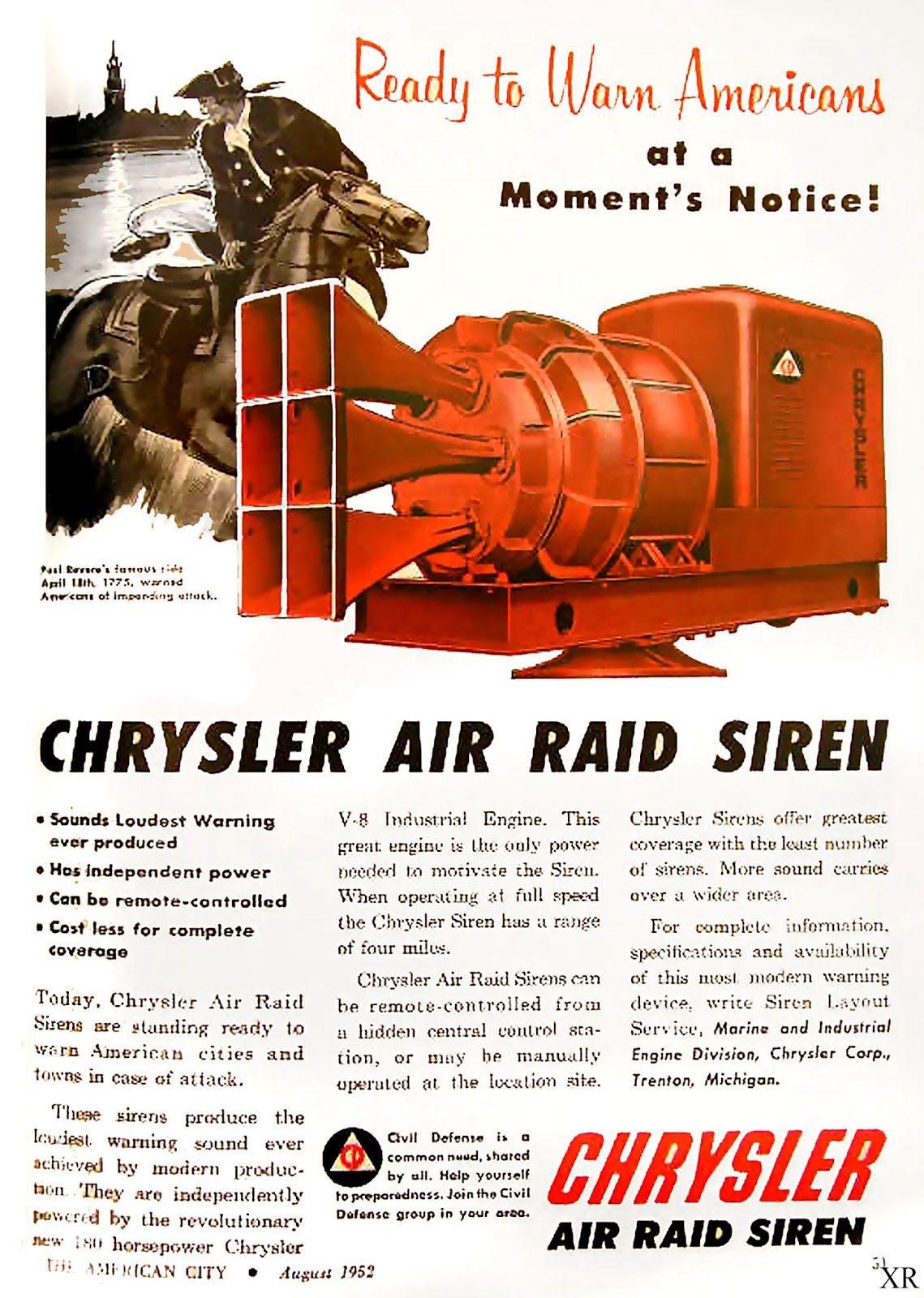
If you were outside, the pamphlet didn’t offer many options and just told you to find cover. Finally, the pamphlet ends by saying that if you see a bright flash of light, you should take cover “instantly.” Thankfully, this time, the operator of a Chrysler Air Raid Siren didn’t have to sacrifice themselves, as the siren could be turned on remotely through a telephone.
As for how to “drive” Chrysler’s Air Raid Siren, that works in a way that you might now expect. First, you’d start your rumbling V8. Once the engine settles into a rhythm, you engage the pulleys, which will then drive the siren as well as the turntable. From there, you just let it rip. The entire siren, engine, fuel tank, operator seat, radiator, and all, was contained on a heavy sled and designed to be placed pretty much wherever it fit, but preferably at the tops of buildings. Here’s a video:
The Chrysler Air Raid Siren is not the only siren in history to be powered by internal combustion. In 1942, there was also the Mobil-Directo Model BN52 and Model BN54, which used Wisconsin VF4 air-cooled V4 engines good for 25 HP.
The Hörmann HLS siren of the mid-1960s used a Farymann G20 diesel engine as its compressor.

There’s even a modern internal combustion siren. Taizhou Lion King Signal produced the Defender, a 130 dB air raid siren powered by a Cummins diesel tuned to 220 HP. This siren was built starting in the 2010s and is still on sale today. Presumably, you can buy one, too, if you have between $200,000 and $300,0000.
Still The Loudest
Some Chrysler sirens were in use until at least the late 1970s. After the Cold War, most Chrysler Air Raid Sirens were disposed of. Some were preserved, and many were abandoned. It’s unclear how many have survived into the modern day. Coincidentally, our pals at Hagerty recently wrote about how a Chrysler Air Raid Siren might end up in New Zealand to be a part of that country’s thriving siren hobbyist scene.
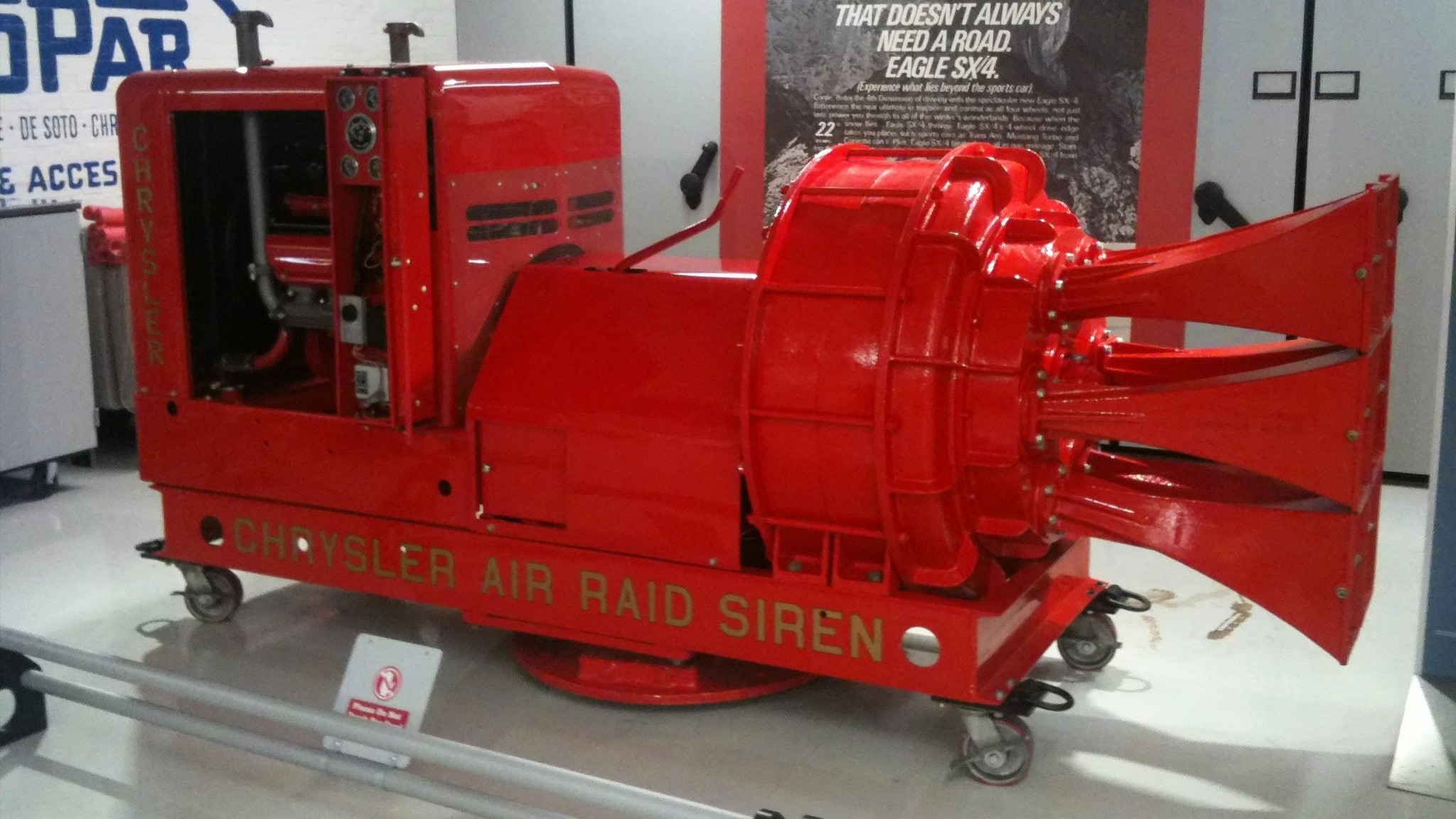
What’s amazing is that the Chrysler Air Raid Siren has held onto its title of being the loudest siren ever since its creation. Today, instead of having one siren to rule them all, alerting duties are handled through systems of smaller, less ridiculous sirens. Sure, a common siren today might have the range of a few miles, but they also don’t weigh three tons or require some poor operator to ride them.
But there was a time when these sirens made total sense. The concern of getting bombed by an enemy was so great that, at least for a blip of time, a viable solution was combining luxury car power with the loudest siren on the planet.
Top photo: Chrysler









Seattle has or had a few of them around. Just for decoration now though.
https://maps.app.goo.gl/dDfVwzeAvg3CvkDm9
https://maps.app.goo.gl/SRToaQ6UCiNfwKvf6
These are so awesome!
“That thing got a HEMI?”
I read about this Hemi siren years ago. It was said that paper or wood put directly in front of the siren at full skip would instantly burst into flames.
I learned about these after falling down the siren rabbit hole living in St Paul. This area still has sirens for tornados, though they say by the time you hear it it’s too late to get real shelter. But we heard them more than once.
Something I never thought I would hear/read:
Chrysler Air Raid Siren might end up in New Zealand to be a part of that country’s thriving siren hobbyist scene.
Thriving…. so that means more than “dozens of us”?
Too bad those abandoned Hemis can’t be put in cars- I’m sure they’re marine versions, designed for steady running.
And still in 2025, every first Tuesday of the month at 10AM, we fire up those sirens.
The area where I grew up had sirens similar to the Thunderbolt pictured above. They would test them monthly. Scared the crap out of me as a little kid – I used to have nightmares about them. But I would like to get my hands on one of those Chryslers – I have a few former neighbors that I would like to settle some old scores with.
That one image looks an awful lot like Rey’s speedster in star wars, wonder if they got the inspiration from this
“Horn and Whistle Magazine” sounds like something Terry Pratchet came up with.
And something Mercedes would subscribe to
One of my favorite “fun facts about the city” that absolutely nobody cares about – Greenville, SC has one sitting on top of the Westin Poinsett hotel downtown. I doubt it works, and it’s clearly abandoned, but it’s not hard to get a glimpse of it sitting up there!
I just checked on Google maps and there’s a few street view perspectives that you can zoom in a get a look at it! Cool stuff!
Thanks for sharing, because of anyone, this is definitely the group that would care about stuff like that.
It’s much lower pitched than I would have imagined. I knew about these, but have never heard one running.
I’ve heard tornado warning sirens in Iowa. Freaked me right out the first time 30 years ago when I was traveling out there for work early in my career. Protip – always know what county you are in when in tornado country, as that is how they give the warnings on the radio. Being from New England where counties are not particularly important and something you rarely think about, it was baffling.
You are the best at finding overlooked topics! But I don’t see the connection with the forst photo, of I-70 passing under the runway at Denver’s old airport. Yes, it’s in period and vaguely sinister. Is that all?
I wanted a car-related photo from some period in the Cold War. My original idea was a 1950s highway, but I went with an old-timey airport approach road.
Not a bad choice, but know that the road here is I-70. Denver’s old airport was small so a N-S runway was added crossing over the highway.
France used to test all its sirens, every Wednesday, until about 10 years ago. Including in Paris which astounded tourists.
Now they have a mobile phone screech for every mobile phone, switched on or not.
Used for flood warnings, except most people did not know what it was for…
The plant I worked in was a former WW2 production site and their siren was powered by steam from the factory power house. Every Friday at 11am that thing would fire up and it was ear piercing. You did not want to be outdoors when it revved up.
I was 9 during the Cuban Missile Crisis. We lived about 10 miles outside Manhattan. They would send us home when the sirens sounded, so we could die with our family. I was a true nerd and new that Soviet missile accuracy was poor. It was most likely that missiles targeted for NYC would land in New Jersey. I was comforted to know that I would die in the blast, rather than from radiation sickness.
Or the Atlantic.
This song seems to fit into this link:
https://youtu.be/yrbv40ENU_o
And this image from your own article feels like the guy on top of it could be a late 50s or early 60s Paul Revere:
https://images-stag.jazelc.com/uploads/theautopian-m2en/Chrysler-Siren-Hemi-2048×1152.jpg